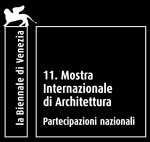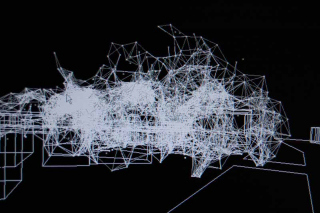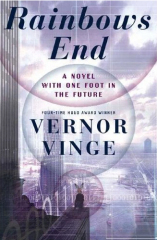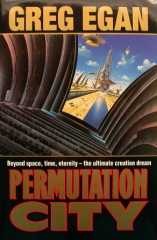Inspirations of the Corpora
Posted by PeterFuchs on September 8th, 2008, filed in documents, faq
Corpora Blog editor Peter Fuchs was giving a round question for the core members of the doublenegatives architecture group on the possible inspirations of Corpora, and also asked if they can highlight some literally source for further reading.
Corpora Blog: Can you hightlight some inspirations sources for Corpora project? Which projects inspired you, which books, movies, theoretical texts had the most influence on the current stage of Corpora?
Max Rheiner: First of all, I was always very interested on sci-fi books, and there are pretty good sci-fi writers around, and for this project, I was really involved myself with Vernor Vinge, he writes about singularity, and also he writes about how technology changes society, and how this technology influences a certain kind of society, and in this case, I was very interested that he built up these sensor systems.
He made a book about how these sensor systems, these mash networks could actually influence an another kind of spices in a planet.And this was very interesting for me, as he break up the border of what we call an entity: how that would be if different species would merge into a single being? We could say we are different persons each other, we have feelings, we have separate bodies, feet, arms etc., but is it possible to see each other as one, single entity? But could this also be true for a flock or a crowd? – this was quite interesting for me.
I also like the idea of this mash network to act as a nerve system of a bigger being, but still have these small entities what it is made of, which can act independently.
I was also influenced by his new book, the Rainbow’s End, in which the world it totally merged into a augmented reality, actually there is no bordering between, actually everything what you see is somehow one layer of reality.
You can sit here in a park, and besides you , could be hundreds of other people, but the maybe in a different world, in Tokyo, anywhere, but they do not care, and that’s also why I like the augmented reality part of Corpora,because you see something which is not there, but you can see it, projected back to the real space again. And it is not like 3D graphics, not just an image itself, but also the other fact that the date comes from the real area, which you can also see. This kind of feedback loop was also interesting.
Sota Ichikawa: The Corpora was based on the Cellular Automaton and the Game of Life from John Conway, so I can say maybe I was inspired by the novels of Greg Egan, for example the Permutation City: it is about the issue of combing our reality with the computer simulated world and also biotechnology. In these books, one of the main question is, if how much computing capacity is needed for a person to represent themselves in a computer simulated world as real as possible.
Ákos Maróy: For a long time, I have been interested in self organizing systems, and this is what my PHD was about as well, and even before that I was interested in this area. I was very interested about the project, when I first spoke with Sota, because I immediately saw the opportunity to create something which has a self organizational aspect. I would not highlight any specific piece of background literature, the subject of cellular automaton and similar self organizing systems are already widely covered. But there is not much of research results on ‘emergence’ or gaining new consciousness in these systems, and somehow I lack the scientific interest for this new way to approach to these systems.
I find this area very interesting, and I think and even in biology, these are open issues. For example, it is still an open question, if how is a body forming, how does it evolves – this is also a distributed technology. So basically how your limbs are formed, or any of your organs, is not centrally governed, but it is a distributed process.
Actually this is the research area of Bea Oborny, who wrote a text for our Catalog.
I am interested in these systems, and especially on where the element of complexity enters them – that’s what my PHD is about: if you start to build a system with simple components, and some form of complexity enters the system, and you can measure the complexity in some way, and then you can highlight, what it that you have to add to the simple component so that the complexity level rises. Where it this border located, what is the engine for this change, for this new level of complexity to evolve. So, I have found similar traits in Corpora, and theoretically speaking, this was my core interest in the project.
Kaoru Kobata: I would add what an element what is covered in the Corpora in Si(gh)te Concept Book I: The basic way is thinking on the notation system of Corpora, which has now been thirteen years for now, developed form a single Super-Eye notation point. But maybe Sota can give a better explanation on this:
Sota Ichikawa: The idea for the Super Eye came, when I was a student of architecture. There was a competition by that time, the Foreign Office Architects Farshid Moussavi, Alejandro Zaera-Polo designed the Yokohma International Port Terminal,
Yokohma International Port Terminal, Image copyright: http://flickr.com/photos/wivern/27886127/
And I was in the competition team, and when I saw the first schemes, I have realized that the structure is in fact a carpet, a totally manipulated 3D carpet, and it solves its function very well.
And then I saw these drawings, – and maybe it is a little bit difficult to understand, but there were no walls or roofs, everything is mixed, – I immedietly felt it is like a carpet. So I thought that this space does not fit the usual notation system, and maybe if we use some other ‘language’, we might get a new concept of space from it.
Annie Leibovitz’s portrait of Burroughs / copyright (boingboing.net citing an ebay ad)
And I was also very addicted to read the novels of William Burroughs, actually it is a bit difficult to read it, anyway: one of his story which is about a sect of Islam assassins: the Hashshashin, these highly professional killers are using a special notation system for the space, only usable to them, sort of a different system or language.
I was inspired by these protocol systems, which act as a different language for the space and so came the idea for the Super Eye, which is a basic element of the Corpora.
(book covers copyright owned by their creators, and the images are only being used in the article for informational and educational purposes.)













It is very interesting to hear the many different but similar influences that have given you all this common inspiration. I have just been introduced to your initiative, and this is the very first blog post that I am readying. Each of your experiences resonate with me in a holistic sense.
I think you might find the works of Rupert Sheldrake to be insightful in the areas of thought discussed here. His work on Morphogenetic Fields (or Morphic Fields) is quite profound, and speaks volumes to the concepts of an extended entity or singularity. While controversial for several decades already, there is substantial experimental evidence to support the theories. I suspect that the theories, experiments, etc. in his work could provide further inspirations and ideas for your own. I would be curious to know if any of you have stumbled across his work already.